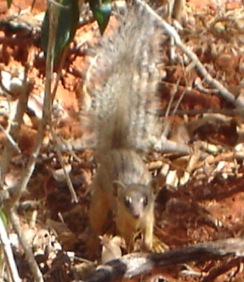Narrow-striped Mongoose (Mungotictis decemlineata) - Wiki Narrow-striped Mongoose
From Wikipedia, the free encyclopedia
[Photo] Taken by Heather Nagy in Parc National de Kirindy Mitea, summer 2006
The Narrow-striped Mongoose (Mungotictis decemlineata), also locally called boky-boky (pronounced "BOO-ky BOO-ky") in Malagasy, is a member of the Eupleridae family, subfamily Galidiinae. It inhabits the dry deciduous forests of western and southwestern Madagascar. To date, it has been found between the Tsiribihina and Mangoky rivers.
Diet, behavior, and habitat
From the few studies done, the Narrow-striped Mongoose is believed to be primarily insectivorous, but has been known to eat bird eggs and a variety of small animals including rodents, birds, snakes, and even small lemur species such as the Gray Mouse Lemur.
The Narrow-striped Mongoose is diurnal and lives in matriarchal family groups that practice cooperative rearing of young. Usually, the young of the alpha female will get the most care, and oftentimes the lower ranking females' young is neglected to the point of abandonment. The Narrow-striped Mongoose creates small nests in trees and brush, and has been known to share trees with Lepilemur species, with which it seemed there was little or no interaction.
Conservation Status
The Narrow-striped Mongoose is currently classified as Endangered by IUCN primarily because of habitat loss. The western dry forests are both highly fragmented and under higher human pressure than the eastern rainforests. The main cause of decimation of dry deciduous forest in Madagascar is tavy (slash-and-burn agriculture) by subsistence farmers, but other causes include logging for wild honey and lumber.
http://en.wikipedia.org/wiki/Narrow-striped_Mongoose
| The text in this page is based on the copyrighted Wikipedia article shown in above URL. It is used under the GNU Free Documentation License. You may redistribute it, verbatim or modified, providing that you comply with the terms of the GFDL. |
